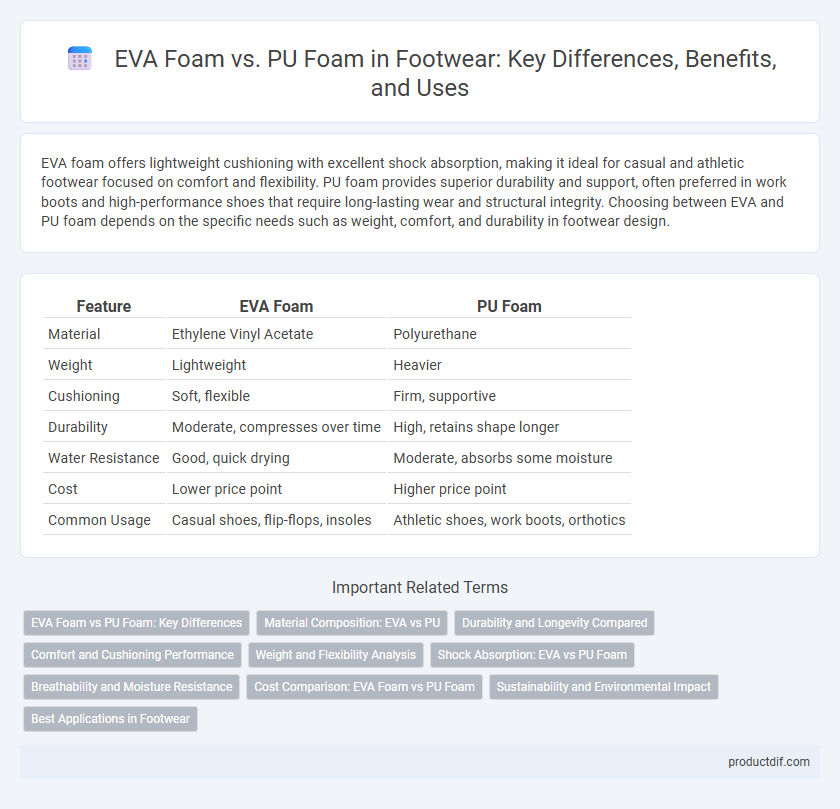EVA foam offers lightweight cushioning with excellent shock absorption, making it ideal for casual and athletic footwear focused on comfort and flexibility. PU foam provides superior durability and support, often preferred in work boots and high-performance shoes that require long-lasting wear and structural integrity. Choosing between EVA and PU foam depends on the specific needs such as weight, comfort, and durability in footwear design.
Table of Comparison
| Feature | EVA Foam | PU Foam |
|---|---|---|
| Material | Ethylene Vinyl Acetate | Polyurethane |
| Weight | Lightweight | Heavier |
| Cushioning | Soft, flexible | Firm, supportive |
| Durability | Moderate, compresses over time | High, retains shape longer |
| Water Resistance | Good, quick drying | Moderate, absorbs some moisture |
| Cost | Lower price point | Higher price point |
| Common Usage | Casual shoes, flip-flops, insoles | Athletic shoes, work boots, orthotics |
EVA Foam vs PU Foam: Key Differences
EVA foam offers superior cushioning and lightweight properties, making it ideal for athletic and casual footwear, while PU foam provides greater durability and support, commonly used in work boots and high-performance shoes. EVA's closed-cell structure enhances water resistance and flexibility, whereas PU foam's open-cell design delivers better shock absorption and resilience over time. The choice between EVA and PU foam depends on the desired balance of comfort, longevity, and footwear application.
Material Composition: EVA vs PU
EVA foam consists of ethylene-vinyl acetate copolymer, providing lightweight cushioning and excellent shock absorption in footwear. PU foam is made from polyurethane, known for its durability, higher density, and superior support in midsoles and insoles. The choice between EVA and PU foam impacts comfort, weight, and longevity of shoes.
Durability and Longevity Compared
EVA foam offers exceptional durability due to its lightweight and flexible structure, providing long-lasting cushioning that resists cracking and compression over time. PU foam, while denser and heavier, excels in maintaining support under prolonged stress, contributing to extended footwear lifespan in rugged conditions. Choosing between EVA and PU foam depends on the desired balance between shock absorption, wear resistance, and longevity in specific footwear applications.
Comfort and Cushioning Performance
EVA foam offers superior lightweight cushioning and excellent shock absorption, making it ideal for prolonged comfort in footwear. PU foam provides enhanced durability and denser support, ensuring long-lasting comfort with better energy return during high-impact activities. Both materials optimize cushioning, but EVA excels in softness while PU prioritizes structural resilience.
Weight and Flexibility Analysis
EVA foam is significantly lighter than PU foam, making it ideal for footwear requiring reduced weight and enhanced comfort. The closed-cell structure of EVA provides superior flexibility, allowing better shock absorption and adaptability to foot movements. PU foam, while denser and heavier, offers more durability but compromises in weight and flexibility compared to EVA.
Shock Absorption: EVA vs PU Foam
EVA foam offers superior shock absorption due to its lightweight, flexible structure that compresses and rebounds quickly, making it ideal for athletic footwear. PU foam provides denser cushioning with higher durability but tends to absorb less impact energy, resulting in firmer support suitable for work boots or heavy-duty shoes. Understanding these differences is crucial for selecting footwear that balances comfort, performance, and longevity based on activity requirements.
Breathability and Moisture Resistance
EVA foam offers superior breathability due to its open-cell structure, allowing better air circulation within footwear, which reduces heat buildup and enhances comfort. PU foam excels in moisture resistance because of its closed-cell composition, making it less absorbent and more durable in wet conditions. Choosing EVA foam is ideal for breathability-focused designs, while PU foam suits footwear requiring enhanced moisture protection.
Cost Comparison: EVA Foam vs PU Foam
EVA foam is generally more cost-effective than PU foam, making it a popular choice for budget-friendly footwear production. The lower material and manufacturing costs of EVA foam contribute to reduced overall expenses without compromising lightweight cushioning. PU foam, while pricier, offers enhanced durability and support, which can justify the higher initial investment for premium footwear models.
Sustainability and Environmental Impact
EVA foam offers a more sustainable option compared to PU foam due to its lower carbon footprint and recyclability, reducing landfill waste. PU foam, derived from petroleum, involves energy-intensive manufacturing processes and releases toxic chemicals during decomposition. Choosing EVA foam can significantly minimize environmental impact in footwear production by promoting biodegradability and reducing harmful emissions.
Best Applications in Footwear
EVA foam excels in lightweight, flexible footwear such as running shoes and casual sneakers due to its superior cushioning and shock absorption properties. PU foam offers greater durability and support, making it ideal for work boots and hiking shoes that require enhanced stability and resistance to compression. Selecting EVA foam benefits performance-oriented footwear, while PU foam suits rugged, long-lasting applications.
EVA foam vs PU foam Infographic

 productdif.com
productdif.com